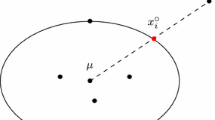Abstract
The score tests of independence in multivariate extreme values derived by Tawn (Tawn, J.A., “Bivariate extreme value theory: models and estimation,” Biometrika 75, 397–415, 1988) and Ledford and Tawn (Ledford, A.W. and Tawn, J.A., “Statistics for near independence in multivariate extreme values,” Biometrika 83, 169–187, 1996) have non-regular properties that arise due to violations of the usual regularity conditions of maximum likelihood. Two distinct types of regularity violation are encountered in each of their likelihood frameworks: independence within the underlying model corresponding to a boundary point of the parameter space and the score function having an infinite second moment. For applications, the second form of regularity violation has the more important consequences, as it results in score statistics with non-standard normalisation and poor rates of convergence. The corresponding tests are difficult to use in practical situations because their asymptotic properties are unrepresentative of their behaviour for the sample sizes typical of applications, and extensive simulations may be needed in order to evaluate adequately their null distribution. Overcoming this difficulty is the primary focus of this paper.
We propose a modification to the likelihood based approaches used by Tawn (Tawn, J.A., “Bivariate extreme value theory: models and estimation,” Biometrika 75, 397–415, 1988) and Ledford and Tawn (Ledford, A.W. and Tawn, J.A., “Statistics for near independence in multivariate extreme values,” Biometrika 83, 169–187, 1996) that provides asymptotically normal score tests of independence with regular normalisation and rapid convergence. The resulting tests are straightforward to implement and are beneficial in practical situations with realistic amounts of data.
Similar content being viewed by others
References
Capéraà, P., Fougères, A.-L. and Genest, C., “A nonparametric estimation procedure for bivariate extreme value copulas,” Biometrika 84, 567–577, (1997).
Capéraà, P., Fougères, A.-L. and Genest, C., “Bivariate distributions with given extreme value attractors,” J. Multivar. Anal. 72, 30–49, (2000).
Clayton, D.G., “A model for association in bivariate life tables and its application in epidemiological studies of familial tendency in chronic disease incidence,” Biometrika 65, 141–151, (1978).
Coles, S.G., An Introduction to Statistical Modelling of Extreme Values, Springer, London, UK, 2001.
Coles, S.G. and Tawn, J.A., “Modelling extreme multivariate events,” J. R. Stat. Soc., B 53, 377–392, (1991).
Coles, S.G. and Tawn, J.A., “Statistical methods for multivariate extremes: an application to structural design (with discussion),” Appl. Stat. 43, 1–48, (1994).
Crowder, M., “On some nonregular tests for a modified Weibull model,” Biometrika 77, 449–506, (1990).
Davison, A.C. and Smith, R.L., “Models for exceedances over high thresholds (with discussion),” J. R. Stat. Soc., B 52, 393–442, (1990).
Deheuvels, P., “Some applications of the dependence functions to statistical inference: nonparametric estimates of extreme value distributions, and a Kiefer type universal bound for the uniform test of independence,” Colloq. Math. Societ. János Bolyai. 32. Nonparam. Stat. Infer., Budapest (Hungary) 32, 183–201, (1980).
Deheuvels, P. and Martynov, G., “Cramér-Von Mises-Type tests with applications to tests of independence for multivariate extreme value distributions,” Commun. Stat., Theory Methods 25(4), 871–908, (1996).
Dorea, C. and Miasaki, E., “Asymptotic test for independence of extreme values,” Acta Math. Hung. 62(3–4), 343–347, (1993).
Embrechts, P., Klüppelberg, C. and Mikosch, T., Modelling Extremal Events, Springer, New York, 1997.
Genest, C. and Rivest, L.-P., “On the multivariate probability integral transform,” Stat. Probab. Lett. 53, 391–399, (2001).
Heffernan, J.E. and Tawn, J.A., “A conditional approach for multivariate extreme values (with discussion),” J. R. Stat. Soc., B 66(Part 3), 497–546, (2004).
Joe, H., “Families of min-stable multivariate exponential and multivariate extreme value distributions,” Stat. Probab. Lett. 9, 75–82, (1989).
Joe, H., Multivariate Models and Dependence Concepts, Chapman & Hall, London, 1997.
Kimber, A.C. and Zhu, C.Q., “Diagnostic for a Weibull frailty model,” in Statistical Inference and Design of Experiments (U.J. Dixit and M.R. Satam, eds.), Mumbai, Narosa, 36–46, (1999).
Kimber, A.C., Sarker, M.J. and Zhu, C.Q., “Some tests for frailty in bivariate Weibull lifetime data,” Submitted, (2005).
Kotz, S. and Nadarajah, S., Extreme Value Distributions, Imperial College Press, London, UK, 2000.
Leadbetter, M.R., Lindgren, G. and Rootzén, H., Extremes and Related Properties of Random Sequences and Series, Springer, New York, 1983.
Ledford, A.W. and Tawn, J.A., “Statistics for near independence in multivariate extreme values,” Biometrika 83, 169–187, (1996).
Ledford, A.W. and Tawn, J.A., “Modelling dependence within joint tail regions,” J. R. Stat. Soc., B 59, 475–499, (1997).
Resnick, S.I., Extreme Values, Regular Variation and Point Processes, Springer, New York, 1987.
Self, S.G. and Liang, K.-Y., “Asymptotic properties of maximum likelihood estimators and likelihood ratio tests under non-standard conditions,” J. Am. Stat. Assoc. 82, 605–610, (1987).
Shi, D., Smith, R.L. and Coles, S.G., Joint versus marginal estimation for bivariate extremes, Tech. Rep. 2074, Department of Statistics, University of North Carolina, Chapel Hill, 1992.
Sibuya, M., “Bivariate extreme statistics,” Ann. Inst. Stat. Math. 11, 195–210, (1960).
Smith, R.L., “Maximum likelihood estimation in a class of nonregular cases,” Biometrika 72, 67–90, (1985).
Smith, R.L., “Extreme value analysis of environmental time series: an application to trend detection in ground-level ozone (with discussion),” Stat. Sci. 4, 367–393, (1989).
Stephenson, A., “Simulating multivariate extreme value distributions of logistic type,” Extremes 6, 49–59, (2003).
Stephenson, A. and Tawn, J.A., “Exploiting occurrence times in likelihood inference for componentwise maxima,” Biometrika 92(1), 213–227, (2005).
Tawn, J.A., “Bivariate extreme value theory: models and estimation,” Biometrika 75, 397–415, (1988).
Tiago de Oliveira, J. “Structure theory of bivariate extremes, extensions,” Est. Mat., Estat. e Econ 7, 165–195, (1962/1963).
Author information
Authors and Affiliations
Corresponding author
Additional information
AMS 2000 Subject Classification
Primary—60G70
Secondary—62H15
Rights and permissions
About this article
Cite this article
Ramos, A., Ledford, A. Regular Score Tests of Independence in Multivariate Extreme Values. Extremes 8, 5–26 (2005). https://doi.org/10.1007/s10687-005-4857-4
Received:
Revised:
Accepted:
Published:
Issue Date:
DOI: https://doi.org/10.1007/s10687-005-4857-4




